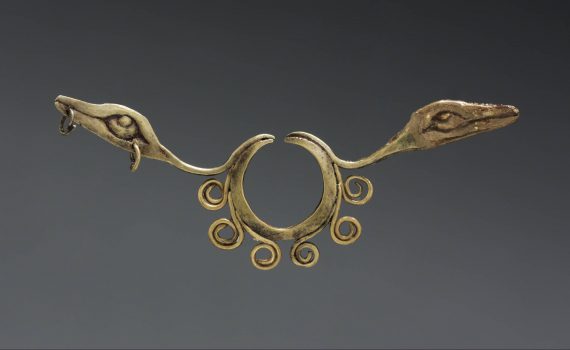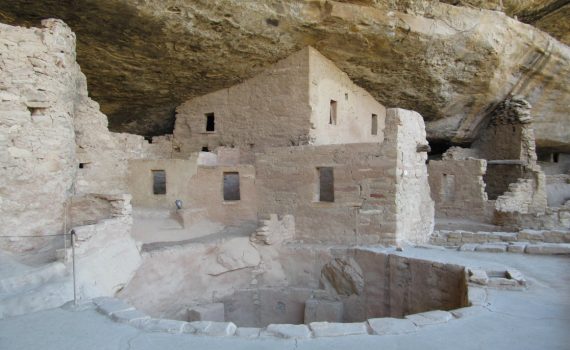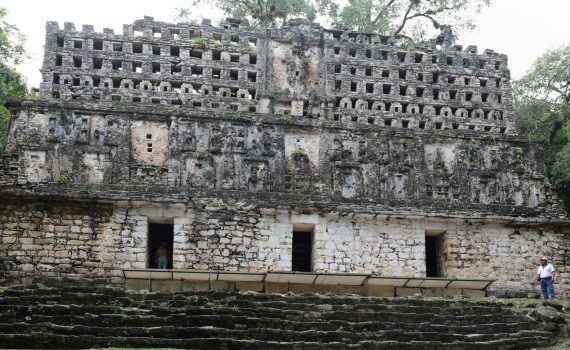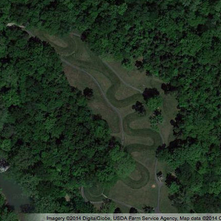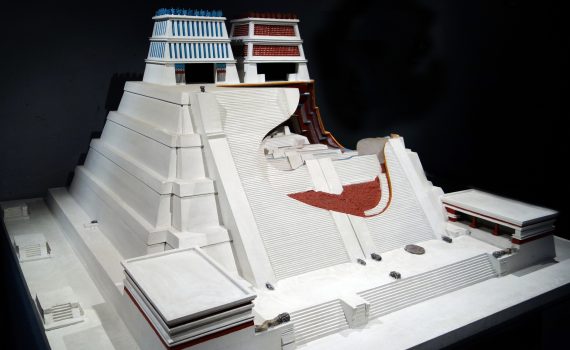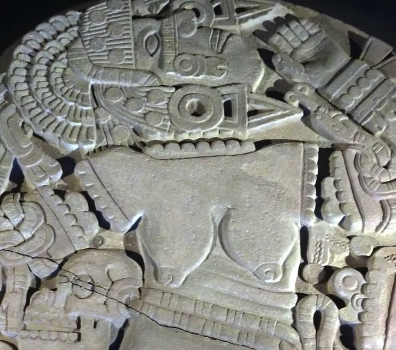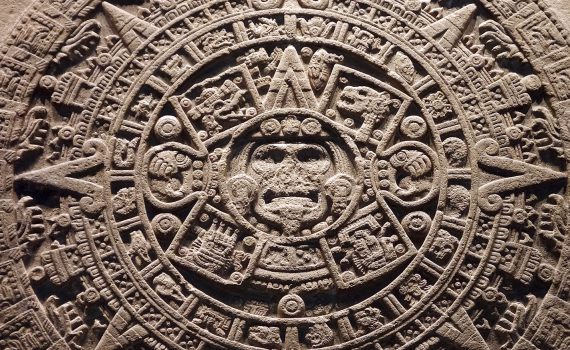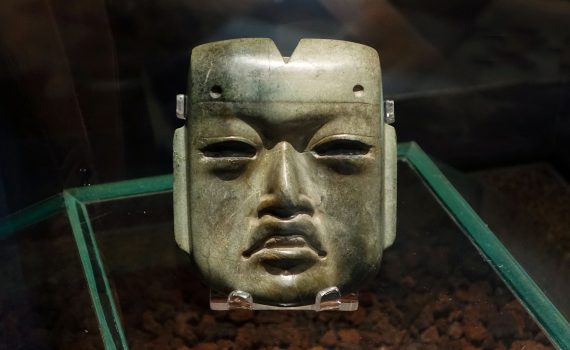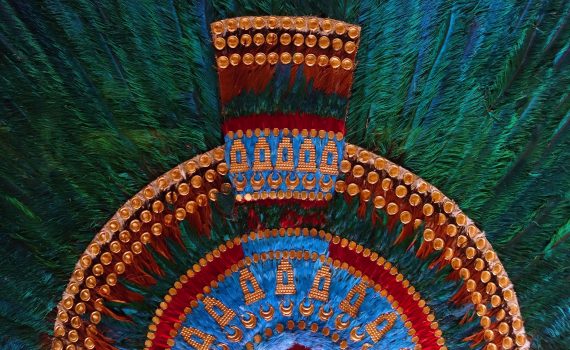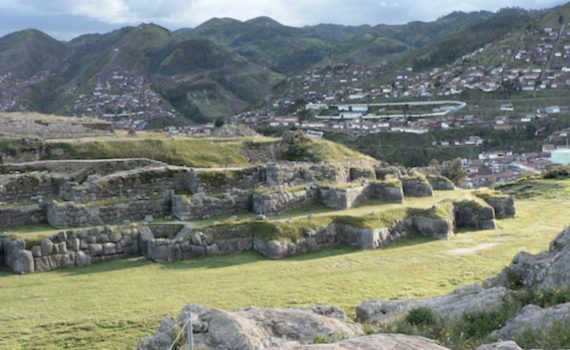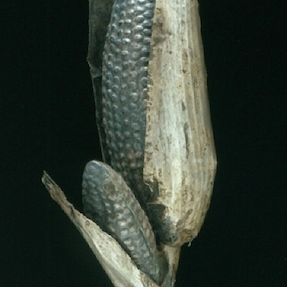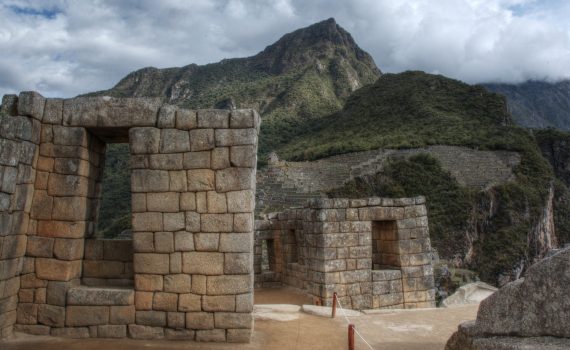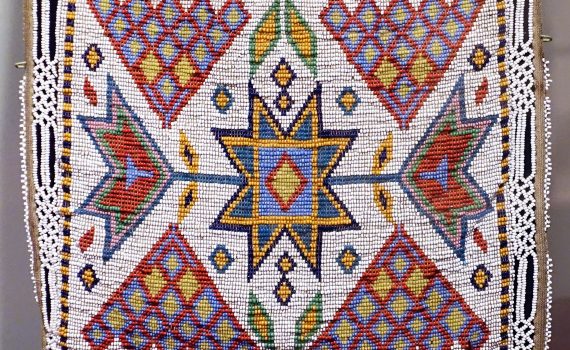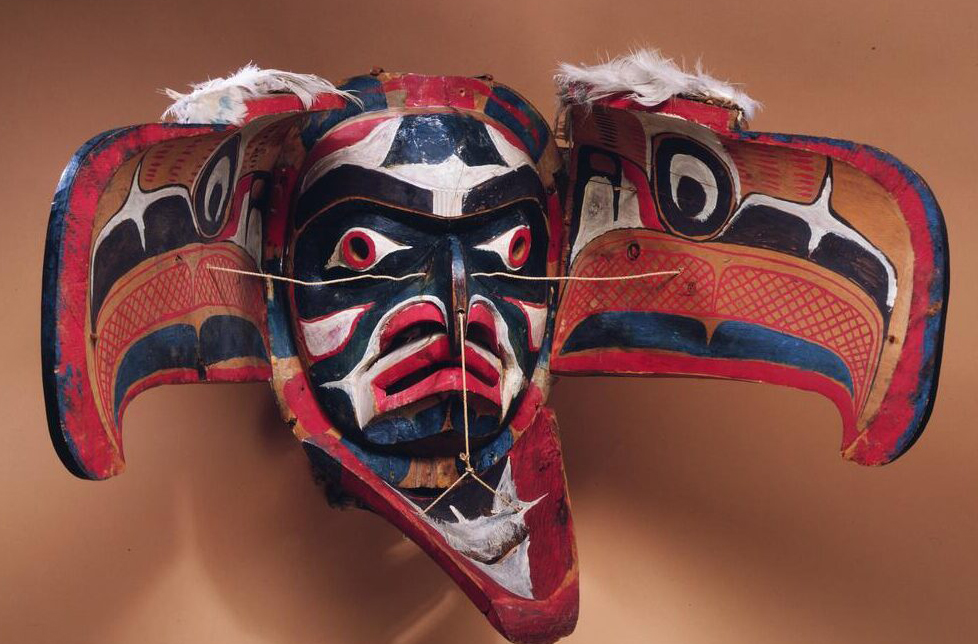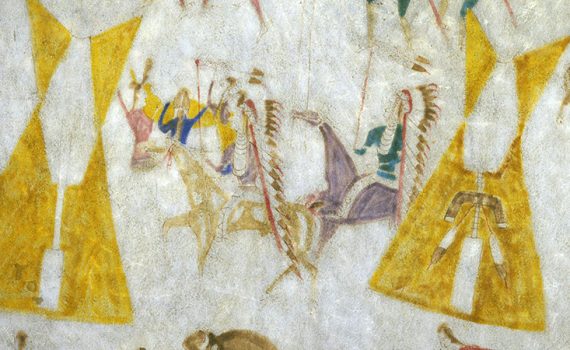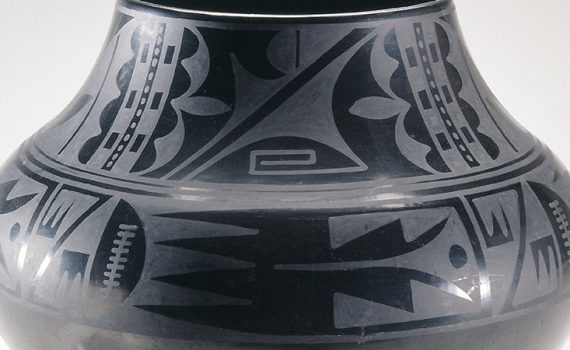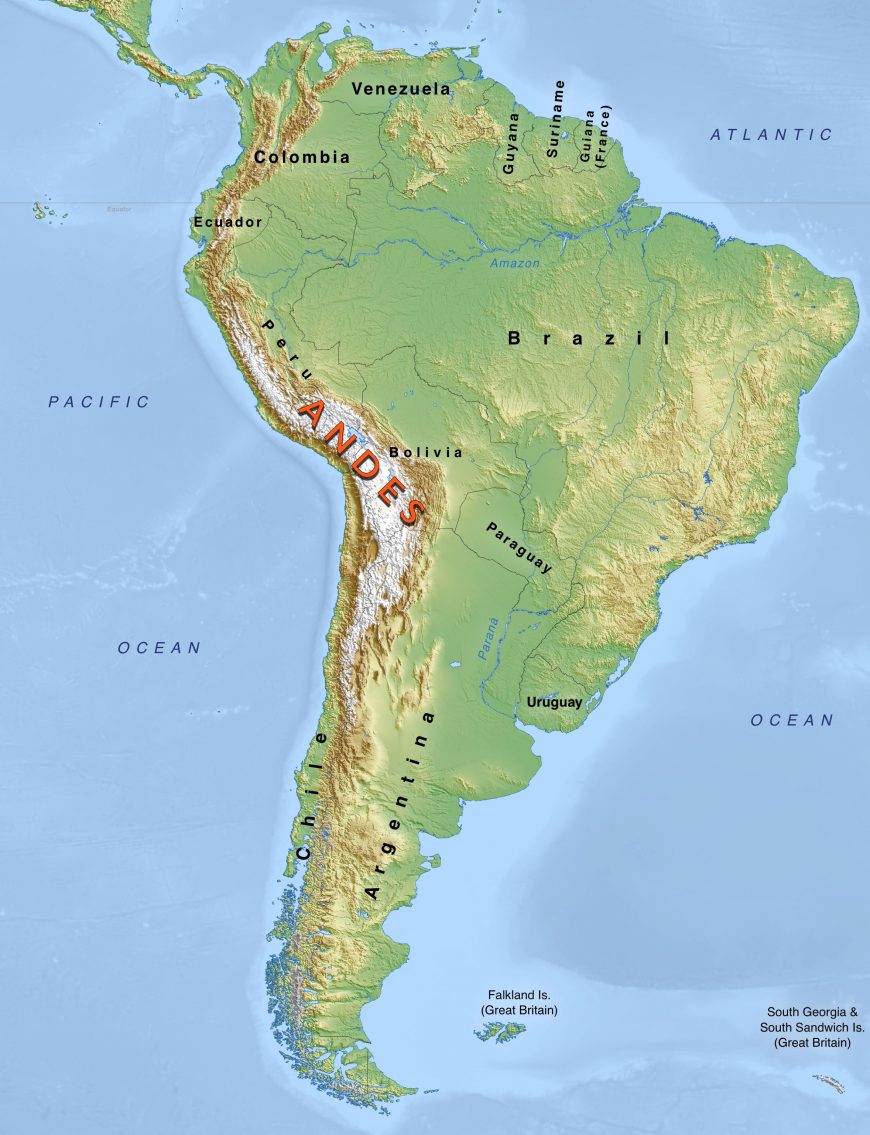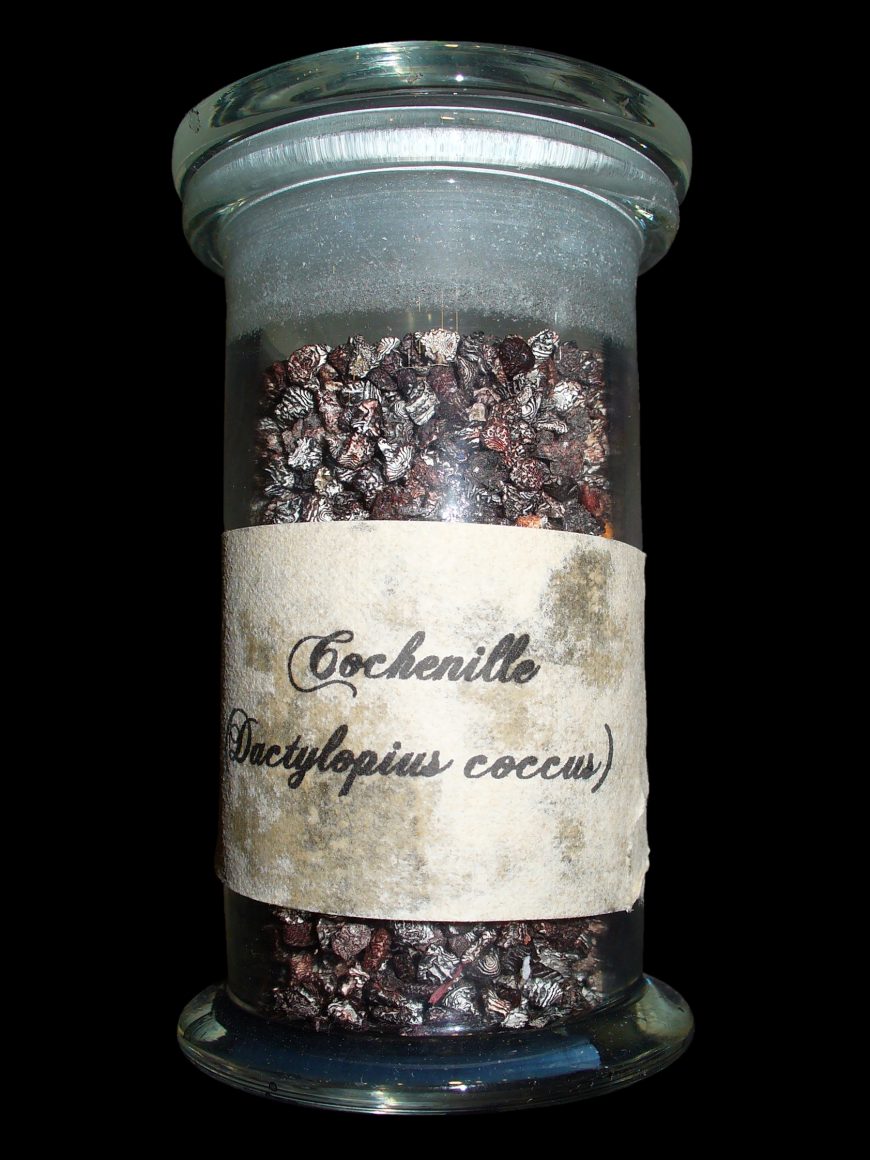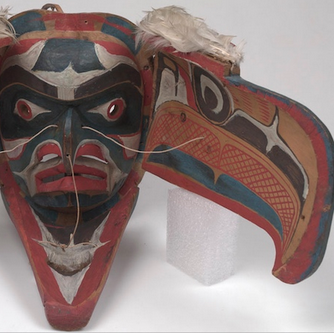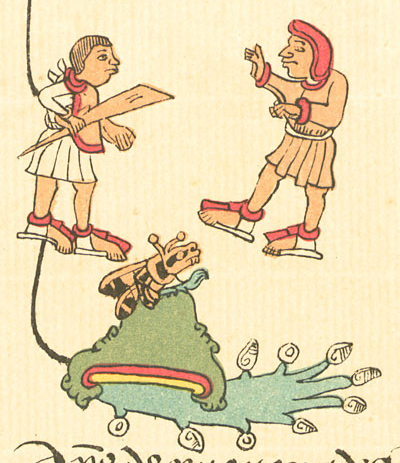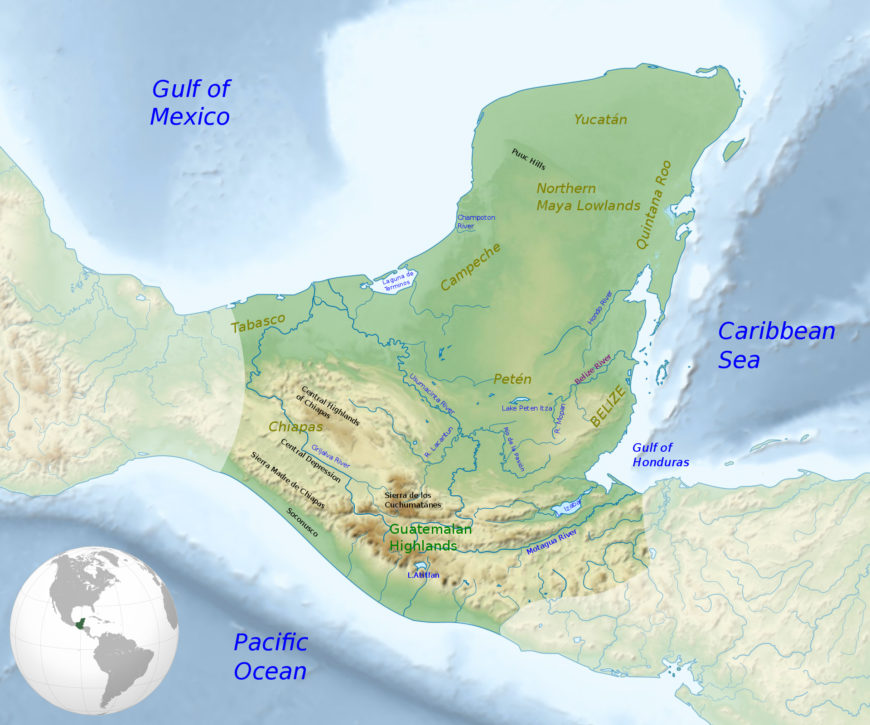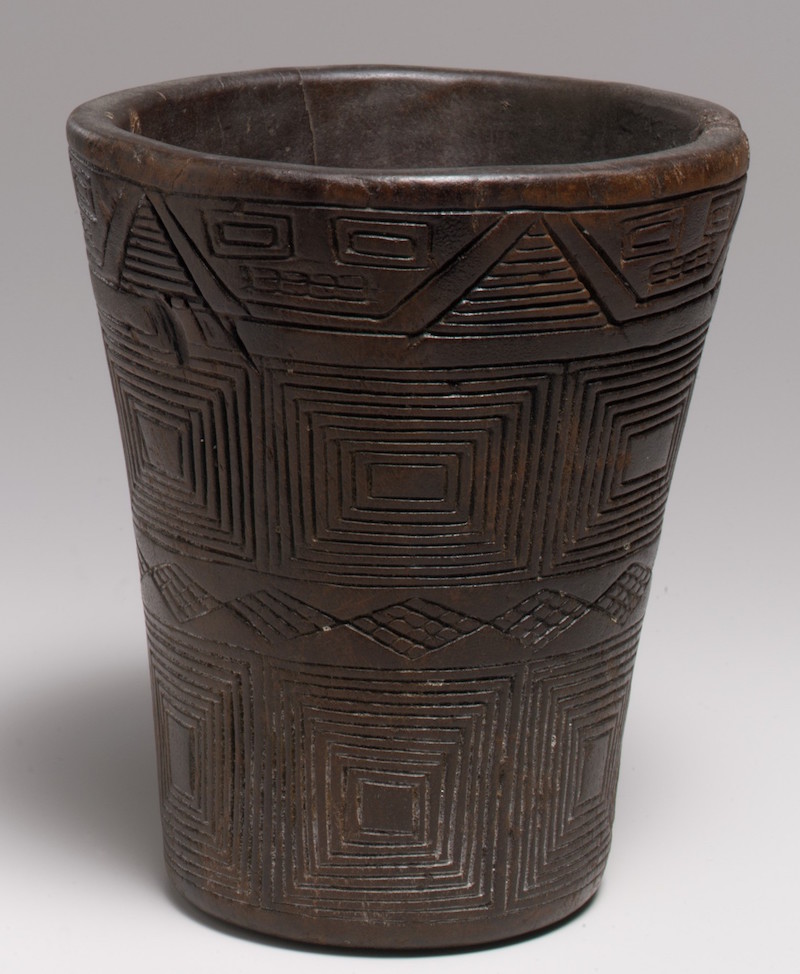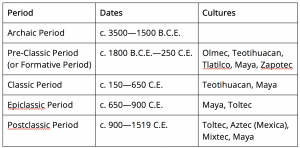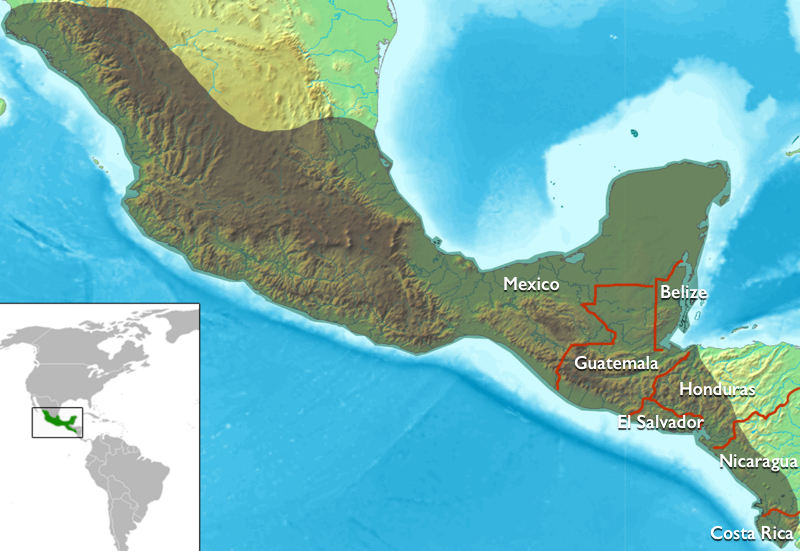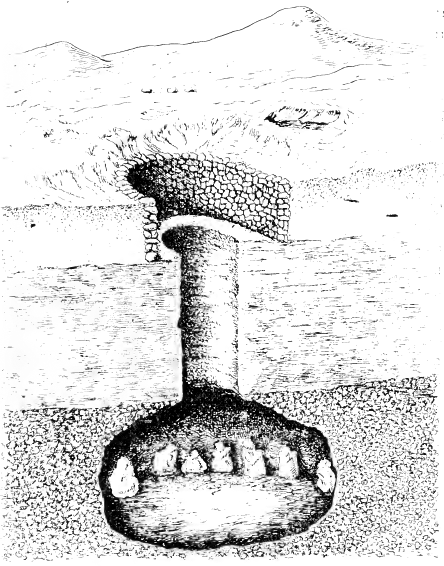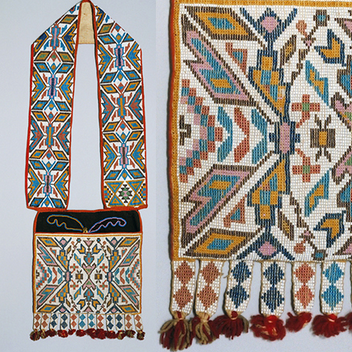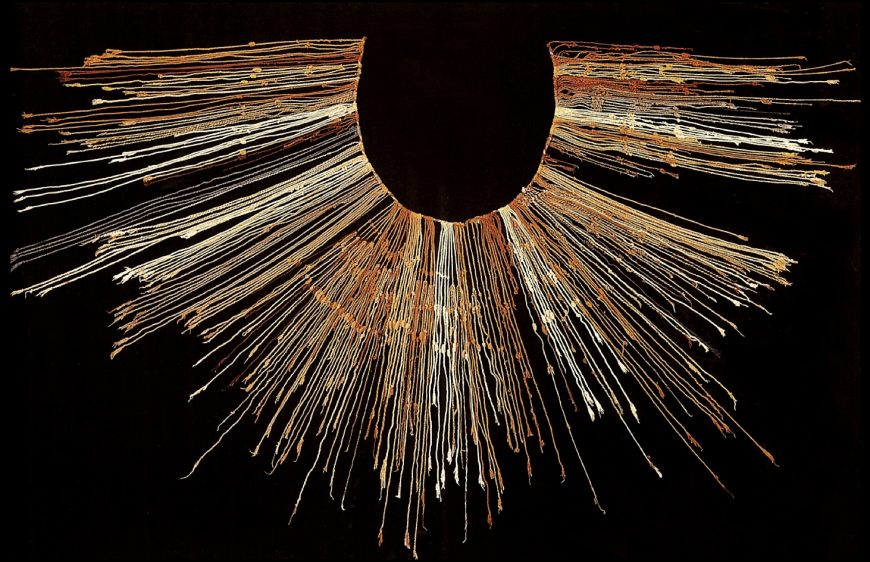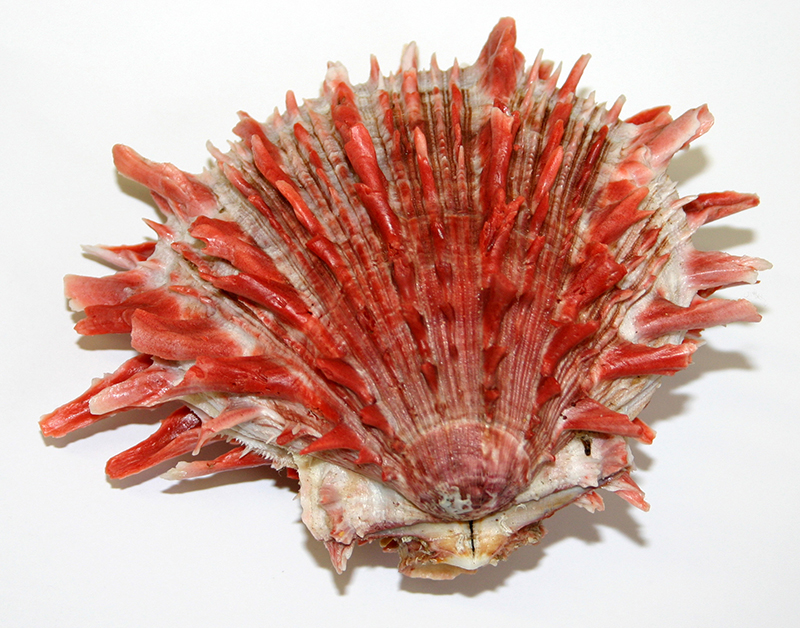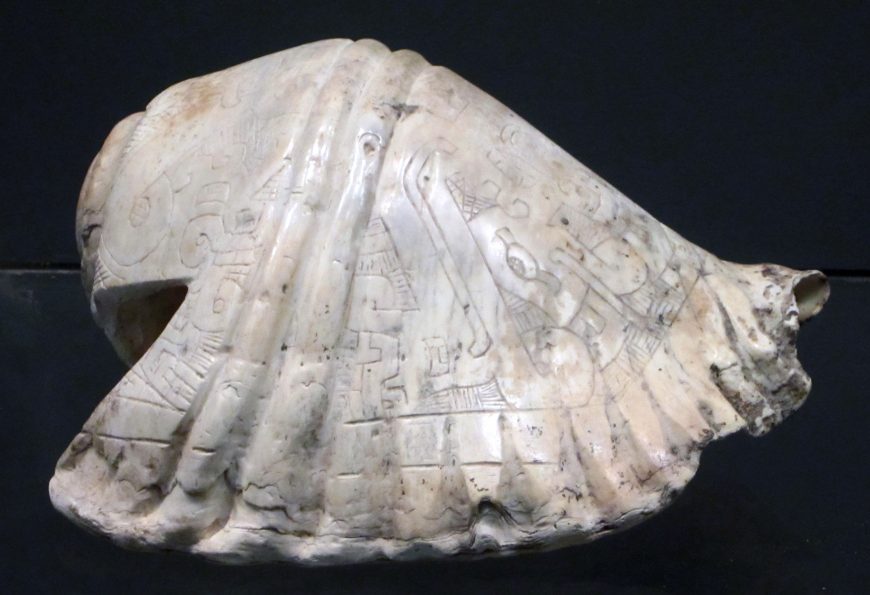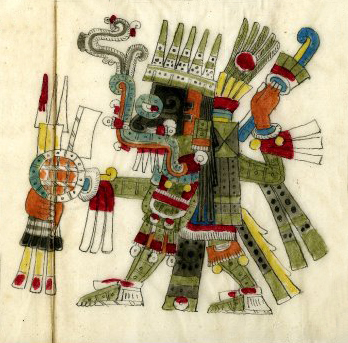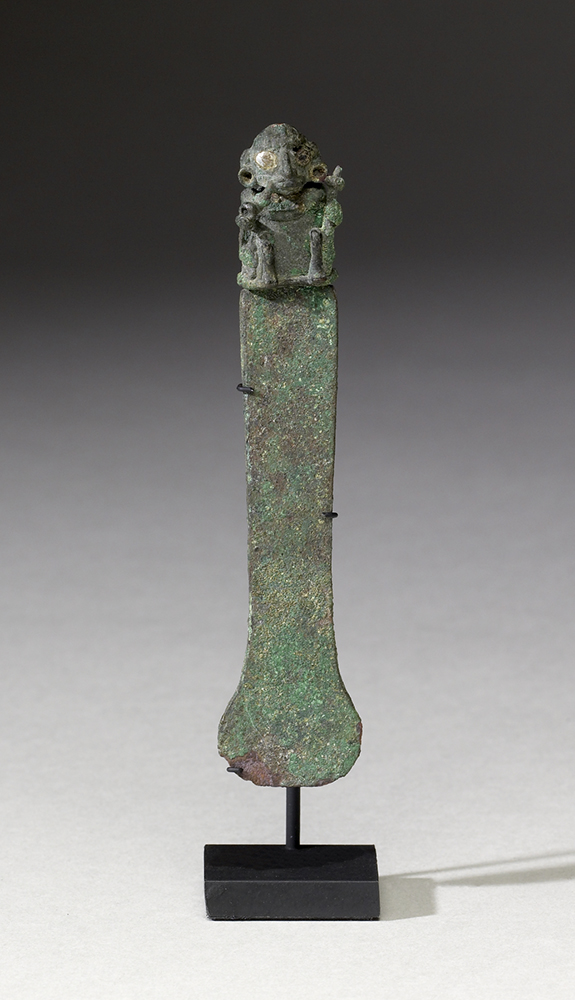Click on any icon to make it larger.
| aclla |
A “chosen woman” in the Inka Empire who weaved fine cloth for gods and nobles.
|
| accoutrements | Accoutrements are additional items, such as jewelry, that are worn or used by a person. |
| adobe | Adobe buildings are typically earthen brick structures commonly made of clay, sand, silt, and straw. |
| adzes | An adze is similar to an axe but its blade is turned 90 degrees so it is at a right angle to the handle. Some so called stone adze reference the shape of the blade but were not intended for cutting.
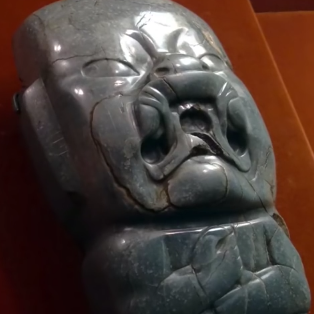 Votive Adze “Kunz Axe,” c. 1200-500 B.C.E., jadeite, 31 x 16 x 11 cm, Olmec Formative Period |
| alpaca | A type of camelid found in the Andean region. Alpacas have soft wool and were sheared to make textiles.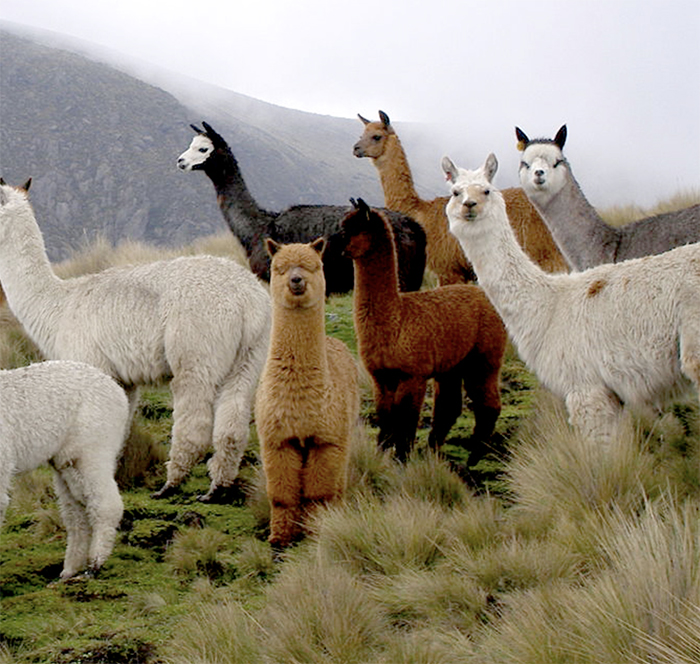 |
| amanteca |
The name for Nahua featherworkers, who comprised their own special social class. In the Mexica capital of Tenochtitlan, they lived in a neighborhood called Amantla, which is why they were called amanteca.
|
| ancestral Puebloans | The ancestral Puebloans were an ancient culture residing in the Four Corners region. Many Pueblo people today consider themselves descendants of this culture. The ancestral Puebloans have sometimes been referred to as the Anasazi, but this term, which is a Navajo word meaning “enemy ancestors,” is considered objectionable by many modern Pueblo people. |
| The Andes |
“The Andes” can refer to the mountain range that stretches along the west coast of South America, but is also used to refer to a broader geographic area that includes the coastal deserts to the west and into the tropical jungles to the east of those mountains. This region is seen as home to a distinct cultural area—dating from around the fourth millennium B.C.E. to the time of the Spanish conquest—and many of these cultures still persist today in various forms.
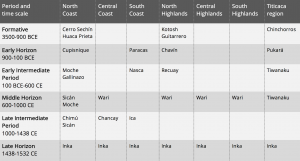 |
| Andean highlands | Located between the coastal deserts and snow-capped Andean mountains, the highlands are home to fertile valleys, plateaus, and grasslands. The highlands are above 8,000 feet. Valleys can have temperate climates, while the plateaus and grasslands can have much colder, more severe weather. |
| anthropomorphic | Anthropomorphic means having a human form. |
| archaic | The word “archaic” refers to art of earlier cultures. |
| art for art’s sake | This term refers to art made purely for the purpose of enjoyment. |
| atl-tlachinolli |
Fire and water, known in Nahuatl as atl-tlachinolli (“burnt water”; pronunciation: at-ul tlach-ee-no-lee), symbolized war, which was essential to the expansion of the Mexica empire.
|
| ayllu | A Quechua word that denotes a network of families that often have a common ancestor. |
| axis mundi | Axis mundi is a Latin term that refers to the concept of a central pole or axis that connects heaven and earth. |
| Aztec | They formed part of a larger ethnic group known as the Nahua from Central Mexico whose pre-Hispanic empire was defeated by the Spanish in 1521. This group of people actually called themselves the Mexica. The name Aztec comes from the word Aztlan (their homeland), and it was appended to this group by the German naturalist and explorer Alexander von Humboldt in the 19th century. |
| bloodletting | The act of shedding one’s own blood, often in a ritual context. Reasons for doing it include to honor deities, and to maintain the cosmos and power. |
| blackware | Vessels fired in a kiln deprived of oxygen (referred to as a “reducing atmosphere”), causing the iron compounds in the clay to turn black. The general term for Andean ceramics made this way is “blackware.” |
| camelid | A camelid is a member of the Camelidae family—think camels, llamas, and alpacas. |
| ceque | Imaginary lines, called ceques, connected the Inka Qorikancha to shrines throughout the Cusco valley. |
| Chiapas region | Chiapas is a southern Mexican state bordering Guatemala. |
| chicha |
A type of beer made from maize that was an integral part of Inka social rituals.
|
| chinampas |
Chinampas, or floating gardens, provided the food necessary to sustain the Aztec empire. They consisted of human-made islands where crops could be grown. Food staples included maize, squash, and beans.
|
| coca | There are several species of coca plants. Erythroxylum coca is the variety typically cultivated in the Andean regions discussed here. Coca leaves are the source of the drug cocaine, but when consumed in its organic form, it has less extreme effects. Because of drug trafficking, the cultivation of coca plants is now strictly regulated. |
| cochineal | The cochineal is an insect that lives as a parasite on the prickly pear cactus. When dried and ground, it was used as a red pigment. |
| codex | A word commonly used for screenfold manuscript books. |
| conquistadors | Conquistador means conqueror, and in this case refers to the Spaniards who invaded Mesoamerica. |
| contour rivalry | Contour rivalry occurs when an image can be interpreted in multiple ways, for instance, when a particular figure can be seen when looked at one way, and a different one appears when the image is turned another way.
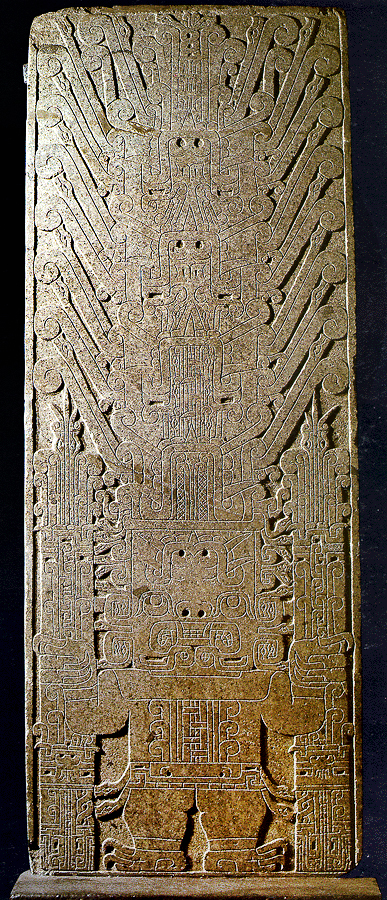 Raimondi Stele, Chavin de Haunter, Peru, c. 400 B.C.E. |
| cornices | A cornice is an architectural element that projects from the top of a wall, either where a wall meets the ceiling, or at the top edge of the exterior of a building. |
| cosmology | Cosmology refers to belief about the order and structure of the universe. |
| crest symbol | Sometimes called a clan emblem, a crest symbol represents a specific clan. These symbols can take the form of animals, ancestors, or supernatural beings, and are important for the history of First Nations peoples across North America. They can help to encode a family’s lineage, among other things. |
| effigy mound | A raised pile of earth built in the shape of a stylized animal, symbol, religious figure, human, or other figures that were common among Indigenous cultures in what is today the U.S. (primarily the eastern half) between about c. 300–1300 C.E. |
| El Niño | El Niño and La Niña are the warm and cool phases of a recurring climate pattern across the tropical Pacific, the El Niño-Southern Oscillation. |
| flowery war | The flowery wars were ritual wars fought by the Aztecs. |
| Four Corners | The Four Corners region includes southeastern Utah, northeastern Arizona, northwestern New Mexico, and southwestern Colorado. |
| gesso | Gesso is a white mixture consisting of a binder, often glue, mixed with chalk, gypsum, or pigment. |
| glosses | Glosses are explanations or interpretations of texts. |
| glyph | A glyph is a symbolic figure or a written character that is based on a picture. |
| hanan |
Upper. The city of Cuzco was divided into hanan and hurin.
|
| Highland Maya region | Located in Mexico, Guatemala, and Honduras. The Maya highlands are above 2,600 ft above sea level. The highlands are located south of the lowlands. See also Lowland Maya region. |
| huey tlatoani |
The Mexica ruler was known as the huey tlatoani (“chief speaker”; pronunciation: whey-tla-toe-anee). There were eleven tlatoque (the plural form of tlatoani) of Tenochtitlan, beginning with Acamapichtli in 1375 and ending with Cuauhtemoc in 1525.
|
| huipil | A square-cut blouse worn by indigenous women in Mexico and Central America. |
| Huitzilopochtli | Huitzilopochtli, a god of war who was associated with the sun, is pronounced “Wheat-zil-oh-poach-lee.” |
| hurin | Lower. The city of Cuzco was divided into hanan and hurin. |
| indigo | Indigo is a natural dye derived from the leaves of certain plants. In South America, this is usually the anil plant. |
| Inti | The Inka sun deity. |
| Isthmian | The Isthmian region refers to the North American Isthmus‚ today, Panama, Costa Rica, and Nicaragua. |
| keru/kero | A ceremonial drinking vessel used by the Inka. |
| Kiva | Circular, subterranean rooms that were often at the center of architectural units in the Southwestern U.S. A kiva typically had a wood-beamed roof held up by six engaged support columns made of masonry above a shelf-like banquette. Other typical features of a kiva include a firepit (or hearth), a ventilation shaft, a deflector (a low wall designed to prevent air drawn from the ventilation shaft from reaching the fire directly), and a sipapu, a small hole in the floor that is ceremonial in purpose. See an example at Mesa Verde. |
| lintel | The beam at the top of a doorway. |
| Lowland Maya region | Located in the northern part of Central America, in the Yucatan peninsula of Mexico, Guatemala, and Belize. The Maya Lowlands range from 25 feet to 2,600 ft above sea level. The lowlands are divided into the northern and southern lowland region. See also Highland Maya region. |
| maguey | Maguey is a type of agave plant. It had several uses, including as an alcoholic beverage and as a glue. |
| maize | Another word word for corn that originally derives from Spanish. |
| Mesoamerica |
The region of Mesoamerica—which today includes central and south Mexico, Belize, Guatemala, and the western portions of Honduras and El Salvador—consists of a diverse geographic landscape of highlands, jungles, valleys, and coastlines. Pre-Columbian Mesoamerican cultures shared certain characteristics such as the ritual ballgame, pyramid building, human sacrifice, maize as an agricultural staple, and deities dedicated to natural forces. Some Mesoamerican societies developed sophisticated systems of writing, as well as an advanced understanding of astronomy. Many of these cultural trademarks persisted for more than 2,000 years across civilizations as distinct as the Olmec (c. 1200–400 B.C.E.) and the Aztec (c. 1345 to 1521 C.E.). Read more here.
|
| Mexica | The Mexica (or Aztecs) formed part of a larger ethnic group known as the Nahua from Central Mexico whose pre-Hispanic empire, the Aztec empire, was defeated by the Spanish in 1521. Mexica is pronounced “Mesh-ee-ka.” |
| mit’a | Originally an Inka tax paid in labor, it was adopted by the Spanish but without the social reciprocity it originally included |
| mnemonic device | A mnemonic device is a memory aid. |
| mummy bundle |
In the Andes, mummy bundles could be wrapped in textiles, and could be buried with offerings of food and jewelry to accompany the deceased into the afterlife. Some of the most elaborate mummy bundles come from Paracas. |
| Nahua | The Mexica (or Aztecs) formed part of a larger ethnic group known as the Nahua from Central Mexico whose pre-Hispanic empire was defeated by the Spanish in 1521. |
| Nahuatl | Nahuatl was the language of the Mexica. Approximately 1.5 million people speak it today, making it one of the most widely-spoken indigenous languages of the Americas. |
| numayn (or ‘na’mina) | Loosely translated, this Kwakwaka’wakw word means “group of fellows of the same kind” (essentially groups that shared a common ancestor). Numayns were responsible for safe-guarding crest symbols and for conveying their specific rights—which might include access to natural resources and rights to sacred names and dances that related to a numayn’s ancestor or the group’s origins. |
| olla | A rounded pot often associated with the Pueblos of the Southwestern U.S. |
| petroglyph | An engraving on a rock. |
| pictograph | Visual representations of people, places, and events act like writing. |
| pigments | Pigments are substances used in paint to give it a particular hue. They are often derived from minerals. |
| Prairie Style |
The Prairie Style used colorful glass beads fashioned in floral patterns. The patterns could be either naturalistic flowers or abstract floral designs. Read about it with the Bandolier Bag.
|
| pre-Columbian |
“Pre-Columbian” refers to the period in the Americas before the arrival of Columbus. It is a problematic term, discussed in more depth here.
|
| potlatch |
A ceremony among Northwest Coastal Indigenous peoples where the host displayed their status, in part by giving away gifts to those in attendance.
|
| pututu |
Carved Strombus shells turned into trumpets, some of which have been found at Chavín.
|
| pyroengraving | A technique used to decorate wood or other materials like gourds with burn marks created with a heated object used to engrave or incise the surface of the object. |
| Qhapac Ñan |
The Inka Empire was connected by a road system—the Qhapaq Ñan—that was used for official Inka business only. |
| qompi | The highest quality woven textiles of the Inka Empire. |
| Quechua | The primary language of the Inka, Quechua is still spoken today by approximately 10 million people in South America, primarily Peru and Bolivia. |
| quetzal | Quetzals are colorful birds native to Mexico and the southern United States. |
| quillwork | A form of embellishment, often on textiles, that is made most often of porcupine quills. |
| quipu | A quipu (or khipu in Quechua) is a knotted string implement that recorded narratives and other types of information. |
| Raimondi Stele | The stele is named after the Italian-Peruvian geographer and scientist Antonio Raimondi, who first documented the stele in 1874. |
| relief | Relief sculpture remains attached to a surface. |
| repoussé | Repoussé is the technique of hammering silver or other metal into relief from the back side. |
| roof comb | A roof comb is a decorative element on the roof of many Maya structures, sometimes solid stone and decorated with mosaic or stucco and sometimes an open lattice. |
| sapote | A fruit-bearing tree found in Mexico, Central America, and parts of South America. |
| schistose | A form of metamorphic rock prone to flaking. |
| screenfold | A single sheet of paper that is then folded like an accordion. The screenfold is a Mesoamerican construction, strikingly different from European manuscripts whose pages are bound on the left side so the reader sees two pages at a time. |
| sherds | Pottery sherds, or potsherds, are broken pieces of ceramic material. |
| slip | Slip is a liquid mixture of clay and/or other materials suspended in water, it can be used as a paint to decorate ceramics before they are fired. |
| Spondylus shell |
Spondylus shells are not native to Peru; they thrive in the warm coastal waters of what is now Ecuador, hundreds of kilometers from Chavín. |
| stela (or stele) | An upright flat slab of stone worked in relief. |
| Sun Dance | The sacred Sun Dance of the Plains tribes was intended to honor the Creator Deity for the earth’s bounty and to ensure this bounty continued. It was a sacred ceremony that tourists and anthropologists often witnessed in the later 19th century, and was outlawed by the U.S. government in 1935. |
| Strombus shell | Strombus can be found in Peruvian waters, but that is the southernmost reach of their range—they are more common in the north. |
| Tawantinsuyu |
The Inka called their empire Tawantinsuyu, usually translated as “Land of the Four Quarters” in their language, Quechua |
| Tenochtitlan | Tenochtitlan was the capital of the Mexica empire. Today it is known today as Mexico City. It is pronounced “Ten-oach-teet-lan.” |
| teocalli | A teocalli is a Mesoamerican pyramid with a temple on top. |
| thatch | Thatch roofs are usually made of straw, leaves, or a similar organic material. |
| Tlaloc | Tlaloc, a rain and agricultural god. |
| Tlaxcala | Tlaxcala was a city-state in central Mexico. |
| tocapu/t’qapu | Tocapu are compartmentalized geometric designs found in Inca textiles.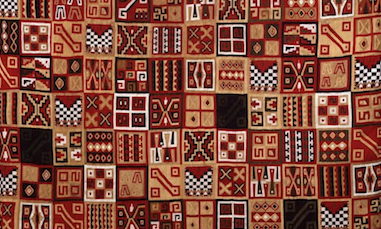 |
| tonalpohualli |
The Aztecs had two different calendars: a 260-day ritual calendar called the tonalpohualli (day count), and a 360-day (plus 5 extra days) calendar called the xiuhpohualli (year count).
|
| tribute | Tribute is a form of payment made to a ruling power or state. |
| tumi | A ceremonial knife used in the Andean region. |
| xiuhpohualli |
The Aztecs had two different calendars: a 260-day ritual calendar and a 360-day (plus 5 extra days) calendar called the xiuhpohualli (year count). The xiuhpohualli was divided into eighteen months of twenty days each, and each of these months had a festival that honored a specific deity or deities.
|

